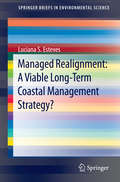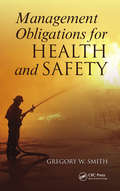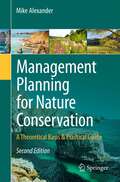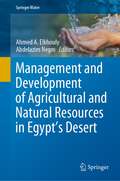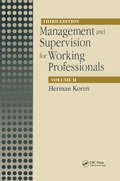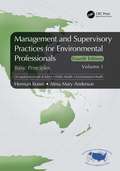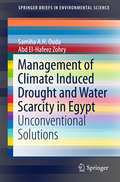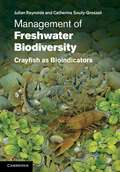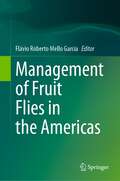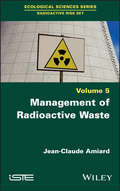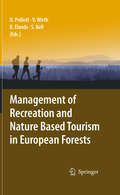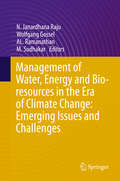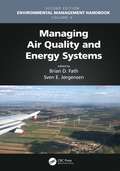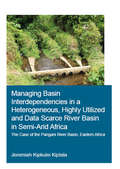- Table View
- List View
Man-Made Closed Ecological Systems
by J.I. Gitelson G.M. LisovskyProviding a broad historical perspective, this book explores the interactions between humans, microorganisms, and plants in a closed habitat, and the life support systems necessary to maintain habitability over long periods of time. Topics include the cultivation of bacteria, microalgae and higher plants; the use of biotechnology to support life outside the Earth's biosphere; methods for recycling air, water and food for human consumption; interactions between humans and other organisms in CMESs; and methods for intensifying the level of photosynthesis. In addition to space the authors investigate problems associated with living conditions in dangerous or difficult environmental areas on Earth such as the Arctic and Antarctica, deserts and mountains.
Managed Realignment: A Viable Long-Term Coastal Management Strategy?
by Luciana S. EstevesManaged realignment has been a preferred coastal management strategy in England in the 21st century and has also been increasingly implemented elsewhere. Climate change and environmental and financial concerns have led to a shift from the traditional 'hold-the-line' approach of coastal protection towards more flexible soft engineering options. Managed realignment is a relatively new soft engineering alternative aiming to provide sustainable flood risk management with added environmental and socio-economic benefits by creating space for coastal habitats to develop more dynamically. The natural adaptive capacity of coastal habitats and the ecosystem services they provide underpin the sustainability of managed realignment. However, many definitions of managed realignment exist and the understanding of what the term actually represents in practice has evolved through time and varies regionally. This book clarifies the definitions and terminology used in the literature and proposes that managed realignment is used as a general term that encompasses the many different methods of implementation worldwide, including: removal, breach and realignment of defences; controlled tidal restoration (which includes regulated tidal exchange and controlled reduced tide); and managed retreat. These methods of implementation are explained and illustrated with examples from around the world. In addition to a general overview of emerging policies and current practices, specific chapters discuss approaches adopted in different locations, including the Netherlands, the UK and Maui (USA). The UK experience is presented from the perspectives of three sectors: the National Trust (a charity organisation that owns 10% of the coastline of England and Wales), the Environment Agency (the organisation responsible for implementing government policy concerning flood and erosion risk) and a private consultant involved in the planning, design and delivery of managed realignment projects. Taking a wider perspective to consider the range of implementation methods, the viability of managed realignment as a long-term coastal management strategy is discussed. Recent national and regional strategies worldwide give managed realignment an increasing role in climate change and flood risk management. Gaining stakeholders and public support is fundamental for the success of emerging coastal management strategies. However, public perception and stakeholders engagement are often cited as a factor limiting the wider uptake of managed realignment. Results from a recent survey are used to benchmark the current thinking about the potential, the performance and the limitations of managed realignment in the UK and elsewhere. Current opinions about managed realignment are often not clearly defined, partly due to many projects being relatively recent. There is a general perception of great potential to provide sustainable flood risk management with added environmental benefits. However, the views of stakeholders are considerably more negative and notably contrast with the views of practitioners and researchers. The only clear and dominant agreement across all groups of respondents is that better understanding about the long-term evolution of sites is needed
Management Obligations for Health and Safety
by Gregory W. SmithIn recent years, the safety management field has placed leadership and commitment at the center of effective workplace health and safety programs. At the same time, personal liability for workplace health and safety has increased, resulting in poor outcomes for individual managers. Discussing the minimum expectations that courts and tribunals have
Management Planning for Nature Conservation: A Theoretical Basis & Practical Guide
by Mike AlexanderThe first edition of Mike Alexander's Management Planning for Nature Conservation, brought a new dimension to the modern literature on conservation management. This second edition, a significant enhancement of the original, deals with the development both, conceptual and practical, of adaptive management planning for nature conservation. It is about preparing management plans, and guides the reader through the entire process. Case-studies, including a conservation and access plan, demonstrate the planning process in action. This approach to planning can be applied to any place which is managed entirely, or in part, for wildlife. It can be applied to the management of species or habitats in any circumstance, regardless of site designation. The process is fully compatible with the Convention on Biological Diversity's 'ecosystem approach' to conservation management. Mike Alexander has long been at the forefront of developing management planning for conservation, with experience ranging from Uganda to Estonia, and from Costa Rica to Wales. He is the General Secretary of the Conservation Management System Consortium, a group of organisations with a common aim of raising standards and developing best practice in conservation management and planning. In 2012 Mike Alexander was elected a Fellow of the Society of Biology in recognition of his contribution to nature conservation and in particular management planning. This book has drawn on the experiences and expertise of the CMS consortium and other leaders in both conservation research and wildlife management from around the world. It is essential reading for professional conservation managers and any student studying management planning for conservation within a range of degree and postgraduate courses.
Management and Development of Agricultural and Natural Resources in Egypt's Desert (Springer Water)
by Abdelazim Negm Ahmed A. ElkhoulyThis book reviews the economic potential of various natural resources found in the Egyptian deserts that could help fill the food gap in Egypt, e.g., the date palm, olives, and domestic animals. Bearing in mind that the entire country is subject to arid or hyperarid climatic conditions, only a small portion (3% of total area) is agriculturally productive in comparison, the dominant deserts. These aspects, combined with a growing population (ca. 100 million citizens) and water resources scarcity, have produced severe adverse effects on natural resource utilization. This book presents innovative methods for addressing desert soil's key problems (soil erosion, salinity, pollution, decreased fertility, minerals, and weed and pest control). Its goal is to help authorities reclaim the desert and optimally utilize the minerals and the available natural resources to support the sustainability agenda 2030. Besides, it offers researchers guidance on remaining gaps and future research directions. Lastly and importantly, it provides essential information on investment opportunities in desert cultivation, such as the fields of food, fodder, and medicinal plants.
Management and Supervision for Working Professionals, Third Edition, Volume I
by Herman KorenThe practical set of methods and tools contained in the two volumes of Management and Supervision for Working Professionals provides the reader with the knowledge and means to become an effective manager or supervisor. Volume I emphasizes organizational structure, planning, and leadership, while Volume II emphasizes communication, instruction, and daily management responsibilities such as performance ratings, unions, and health and safety.
Management and Supervision for Working Professionals, Third Edition, Volume II
by Herman KorenThe practical set of methods and tools contained in the two volumes of Management and Supervision for Working Professionals provides the reader with the knowledge and means to become an effective manager or supervisor. Volume I emphasizes organizational structure, planning, and leadership, while Volume II emphasizes communication, instruction, and daily management responsibilities such as performance ratings, unions, and health and safety.
Management and Supervisory Practices for Environmental Professionals: Advanced Competencies, Volume II
by Herman Koren Alma Mary AndersonBased on the lifelong experiences of two authors as supervisors and teachers, the Fourth Edition of this bestseller provides up-to-date information for newly promoted or management-aspiring professionals and engineers in the fields of environmental health, occupational health and safety, water and wastewater treatment, public health, and many others. This second volume explains the advanced principles that supervisors need to understand the art of communications, resolving communications problems, and the supervisor/manager’s role in teaching, counseling, and managing employee performance and employee health and safety. In addition to those already practicing professionals in their fields, this book is an excellent resource for students interested in learning management skills prior to entering the workforce. Features of the Fourth Edition Helps to understand and utilize organizational structure to facilitate problem solving Offers a practical set of methods, tools, and techniques, all illustrated and easy to understand, for achieving leadership qualities Provides concise but essential discussion material for each topic, using the practical art of communications Includes thorough updates and many new case problems with answers provided Introduces self-testing questions for different situations and practical exercises utilizing an individual’s own work experience for answers
Management and Supervisory Practices for Environmental Professionals: Basic Principles, Volume I
by Herman Koren Alma Mary AndersonBased on the lifelong experiences of two authors as supervisors and teachers, the Fourth Edition of this bestseller provides up-to-date information for newly promoted or management-aspiring professionals and engineers in the fields of environmental health, occupational health and safety, water and wastewater treatment, public health, and many others. This first volume explains, through nine sets of tools, the basic principles supervisors need to understand the structure of their organization, what leadership is, how to effectively plan and budget, how to manage other people, and best practices for achieving success in a management position. In addition to those already practicing professionals in their fields, this book is an excellent resource for students interested in learning management skills prior to entering the workforce. Features of the Fourth Edition Helps to understand and utilize organizational structure to facilitate problem solving Offers a practical set of methods, tools, and techniques, all illustrated and easy to understand, for achieving leadership qualities Provides concise but essential discussion material for each topic, using the practical art of communications Includes thorough updates and many new case problems with answers provided Introduces self-testing questions for different situations and practical exercises utilizing an individual’s own work experience for answers
Management of Climate Induced Drought and Water Scarcity in Egypt
by Samiha A.H. Ouda Abd El-Hafeez ZohryThe book contains suggestion on suitable crop rotations for salt-affected soils to maximize the productivity of lands and water under current climate and under climate change in 2030. This book discusses droughts and water scarcity, which are important issues related to natural phenomena and affected by climate variability and change. It calls for reassessing the prevailing crop structure in Egypt under rain fed irrigation in North Egypt and under surface irrigation in the Nile Delta and Valley. Droughts affect rain fed agriculture, while water scarcity affects irrigated agriculture. The book investigates proposals for improving crop structure in these areas, taking into account the sustainability of water and soil resources. Further, it explores improved management options for crop production in both rain fed and irrigated agriculture. Lastly, it examines suggestions on more rational use of irrigation water in irrigated agriculture to conserve irrigation water under present climate conditions and to help meet the anticipated demand under climate change conditions.
Management of Freshwater Biodiversity
by Catherine Souty-Grosset Julian ReynoldsIntegrating research into freshwater biodiversity and the role of keystone species, this fascinating book presents freshwater crayfish as representatives of human-exacerbated threats to biodiversity and conservation. It uses examples from these and other large decapod invertebrates to explore how communities function and are controlled, alongside the implications of human demands and conflicts over limited resources, notably the severe impacts on biodiversity. The discussion is structured around three key topics - the present situation of crayfish in world freshwater ecosystems, the applications of science to conservation management and knowledge transfer for successful crayfish management. It outlines the historic exploitation of crayfish, addressing the problems caused by invasive alien forms and explaining the importance of correct identification when dealing with conservation issues. Offering a global perspective on freshwater systems, the book ultimately highlights how the conservation of such large and long-lived species will help protect ecosystem quality in the future.
Management of Freshwater Biodiversity
by Catherine Souty-Grosset Julian Reynolds Keith CrandallIntegrating research into freshwater biodiversity and the role of keystone species, this fascinating book presents freshwater crayfish as representatives of human-exacerbated threats to biodiversity and conservation. It uses examples from these and other large decapod invertebrates to explore how communities function and are controlled, alongside the implications of human demands and conflicts over limited resources, notably the severe impacts on biodiversity. The discussion is structured around three key topics - the present situation of crayfish in world freshwater ecosystems, the applications of science to conservation management and knowledge transfer for successful crayfish management. It outlines the historic exploitation of crayfish, addressing the problems caused by invasive alien forms and explaining the importance of correct identification when dealing with conservation issues. Offering a global perspective on freshwater systems, the book ultimately highlights how the conservation of such large and long-lived species will help protect ecosystem quality in the future.
Management of Fruit Flies in the Americas
by Flávio Roberto Mello GarciaThis book comprises issues at the cutting edge of fruit fly management in the Americas, covering topics that are focal points of current activity and likely long-term importance to the progress of the field. The book is an invaluable source of ideas and inspiration for entomologists at all levels from graduate students to more-established researchers and professionals. Fruit flies (Diptera, Tephritidae) is the most important pests of fruit production worldwide. The purpose of this book is to integrate the experiences of leading scientists in the management of fruit flies in the Americas. In this work, species of fruit flies of economic importance are considered in the genera Anastrepha, Rhagoletis, Bactrocera, and Ceratitis. This book will address fruit flies monitoring, biological control, chemical control, cultural control, sterile insect technique (SIT), Integrated Pest Management (IPM), and other control methods. The book provides invaluable resource material to scientists, professionals and students.
Management of Hydrological Systems: Analysis and perspective of the contingent valuation of water for mountain basins
by Holger Manuel Benavides Muñoz Jorge Eugenio Arias Zari Andreas Erwin Fries José Sánchez-Paladines Antonio Jesús Gallegos Reina Raquel Verónica Hernández Ocampo Pablo Ochoa CuevaThe contingent valuation of water is one of the key components when wanting to implement proposals for integrated water management in mountain basins. Management of Hydrological Systems (MHS), is one of the great challenges that the Sustainable Development Goals (SDGs) currently demand. Mainly in mountain basins with fragile ecosystems that face strong pressures such as poverty, urban and population growth, low water supply and sanitation, and climate change. Management of Hydrological Systems aims for sustainable water management, through contingent water valuation, showing the reader in a didactic way the procedure to follow in mountain basins. This book offers a complete characterization of the main problems affecting this type of basin, as well as the detailed procedure of the contingent valuation of water, which directly involves users. As such, this work is offered in relation to this urgent need for practical guidance demanded by society (SDGs), and is based on practical and real examples, rather than theoretical constructions, from places where these issues have not been widely addressed. The text is recommended as a way forward, not only for water resource managers and decision- and policymakers but also for students and teachers who wish to implement this MHS guide.
Management of Indoor Air Quality
by Marzenna R. DudzińskaDue to changes in lifestyle, people spend more time indoors. This refers not only to the time spent at home and at office premises, but also in shopping malls, recreation centers and transport vehicles. Concentrations of many pollutants are higher indoors than they are outdoors. Consequently, the indoor environment has a bigger impact on human heal
Management of Irrigation and Water Supply Under Climatic Extremes: Empirical Analysis and Policy Lessons from India (Global Issues in Water Policy #25)
by M. Dinesh Kumar Nitin Bassi Yusuf Kabir Rushabh HemaniThis volume provides a theoretical basis for the argument that available research that analyzes the impacts of climate on hydrology, water resources, and water systems, without factoring in the effect of climate variability, are inadequate and often misleading. Also, the book empirically shows that the impacts of climate variability on hydrology and water resources, and irrigation, water supply & sanitation systems are far more pronounced than the likely impacts of future change in climate. The book discusses technological, institutional and policy alternatives for reducing these impacts on various competitive use sectors, especially, irrigation, and water supply and sanitation through case studies of river basins in different hydrological setting.To set the context, the volume first presents the long term trends in precipitation and temperature in different regions of India, and compares them against inter-annual, inter-seasonal and intra-day variations in climatic parameters, to show how their differential impacts on water resources.
Management of Park and Recreation Agencies
by Betty Van Der Smissen Merry Moiseichik Vern J. HartenburgAims to more effectively share with students and professionals desirable management practices embodied in the Standards for National Accreditation. The standards are divided into ten categories, which form the basis of the 21 chapters of this book. This book uses the CAPRA Standards to develop an understanding of the components of park and recreation management. Each chapter addresses specific standards, with the standards listed in the Compendium. The thrust of this book is on management of the public agency, the nonprofit association, and the private for-profit enterprise that operates parks, recreation areas and facilities, providing recreation programs and services. It is not on the management of individual parks, or the conduct and supervision of specific recreation programs or leisure services. It is focused on what the manager should know, not what the program director/supervisor or the maintenance supervisor should know.
Management of Radioactive Waste
by Jean-Claude AmiardThe classification of radioactive waste varies from state to state. This results in different management procedures for each country, while following IAEA and OECD/NEA recommendations.Radioactive waste comes from numerous sources. The largest volumes are generated by the decommissioning and dismantling of nuclear facilities. Long-lived, medium- and high-activity waste – categorized as the most hazardous types of waste – are in fact largely produced by nuclear power reactors, spent fuel reprocessing plants and nuclear accidents.Final disposal of very low-activity, low-activity and very short-lived waste is well controlled. However, final solutions for certain categories, including long-lived waste, sorted waste and spent graphite waste, are not yet in place.Management of Radioactive Waste reviews all the possible solutions and presents those chosen by the various states, including a chapter detailing policy on radioactive waste management, taking France as an example.
Management of Recreation and Nature Based Tourism in European Forests
by Simon Bell Ulrike Pröbstl Birgit H. Elands Veronika WirthThis book provides for the first time a Europe-wide overview on the state of the art of management of recreation and nature tourism in forests. It describes the current situation and conflicts in the different regions of Europe and provides solutions illustrated by good practise examples. It addresses traditions, differences and similarities in European forests as well as new tasks, goals and strategies. The final discussion provides a profound insight into future trends regarding forest recreation and nature based tourism.
Management of Soil Problems
by Khan Towhid OsmanSoils are neither good nor bad, but some have inherent or acquired characteristics that may or may not suit our intended use. Unsuitable characteristics are considered to be soil problems, soil constraints or soil limitations. Only twelve percent of global land is right for agricultural production without much limitation. Some soils have severe limitations for crop production. These soils are so called ‘problem soils’. Many of them do not have enough fertility to be productive; some are arid and saline; some are very sandy and dry; and some are wet and waterlogged for most of the growing season. The global demand for food, wood, fuel, fiber, medicine and other plant products for the 7.2 billion current world population has created such an immense pressure on global soil resources that even the most fertile soils are losing their productive capacity. We are being compelled to bring more and more unsuitable or marginally suitable soils under cultivation. Unless innovative and integrated soil, crop and environmental management practices are adopted for their improvement and sustainable use, further degradation is inevitable. This book, Management of Soil Problems, identifies the problems and discusses management options in a smooth and reader-friendly style. It will be useful for students and professionals of soil science, agriculture, forestry, geography and environmental sciences.
Management of Water Resources Using Electrochemical Methods (Environmental Assessment and Management)
by Yong Jiang Guoshuai Liu Changyong ZhangThis book encompasses various approaches to electrochemical water treatment, emphasizing a well-structured framework within the nexus of electrochemistry, water, and energy. It addresses the urgent challenges of water scarcity and pollution and offers practical insights and operational guidance on removing pollutants and preserving water resources through water purification. Applications and real-life case studies support the innovative nature of electrochemical processes as a sustainable and efficient alternative. The user-friendly approach makes this book accessible to a broad audience, being a specialist seeking advanced techniques or a concerned citizen.Features Covers comprehensively the most recent and advanced electrochemical water treatment techniques. Presents practical operational guidelines and insights. Includes real-world examples and case studies. Focuses on environmental impacts and sustainability. Addresses innovative approaches in technology, theoretical computational analysis, and future development guidance for electrochemical water treatment. This book is for professionals, students, and researchers in water and environmental sciences interested in water treatment, management, and resource recovery. It is also a great resource for public and environmental health experts and readers who work in related disciplines and readers interested in water management, treatment, and the health of the environment.
Management of Water, Energy and Bio-resources in the Era of Climate Change: Emerging Issues and Challenges
by N. Janardhana Raju Wolfgang Gossel M. Sudhakar Al. RamanathanGiven our rapidly growing population, the need for judicious management of essential natural resources is becoming a major challenge for planners, managers and scientists/researchers. This book presents a multidisciplinary approach to managing water, energy and bio-resources, described in papers contributed by distinguished scientists and academics working at reputed universities and institutions around the globe. It includes 28 chapters grouped into three sections: Water Resources Management; Energy and Bio-resources Management; and Climate and Natural Resources Management, examining case studies from all over the world. These contributions address current challenges, offering modern techniques for managing these resources in various geographical regions. This volume will provide a valuable asset for researchers and students, managers, environmentalists, hydrologists, water resource and energy managers, governmental and other regulatory bodies dealing with water, energy and bio-resources.
Managing Africa's Natural Resources
by Kobena T. Hanson Cristina D'Alessandro Francis OwusuThe authors investigate well-known concerns in natural resource management in Africa while focusing on the capacity dimension of the problems. They examine dynamics of leadership, governance, criminality, structural transformation, as well as emerging issues such as green growth.
Managing Air Quality and Energy Systems
by Brian D. Fath Sven E. JørgensenBringing together a wealth of knowledge, the Handbook of Environmental Management, Second Edition, gives a comprehensive overview of environmental problems, their sources, their assessment, and their solutions. Through in-depth entries, and a topical table of contents, readers will quickly find answers to questions about pollution and management issues. This six-volume set is a reimagining of the award-winning Encyclopedia of Environmental Management, published in 2013, and features insights from more than 500 contributors, all experts in their fields. The experience, evidence, methods, and models used in studying environmental management is presented here in six stand-alone volumes, arranged along the major environmental systems. Features of the new edition: The first handbook that demonstrates the key processes and provisions for enhancing environmental management. Addresses new and cutting -edge topics on ecosystem services, resilience, sustainability, food-energy-water nexus, socio-ecological systems and more. Provides an excellent basic knowledge on environmental systems, explains how these systems function and offers strategies on how to best manage them. Includes the most important problems and solutions facing environmental management today. In this second volume, Managing Air Quality and Energy Systems, the reader is introduced to the general concepts and processes of the atmosphere, with its related systems. This volume explains how these systems function and provides strategies on how to best manage them. It serves as an excellent resource for finding basic knowledge on the atmosphere, and includes important problems and solutions that environmental managers face today. This book practically demonstrates the key processes, methods, and models used in studying environmental management.
Managing Basin Interdependencies in a Heterogeneous, Highly Utilized and Data Scarce River Basin in Semi-Arid Africa: The Case of the Pangani River Basin, Eastern Africa (IHE Delft PhD Thesis Series)
by Jeremiah Kipkulei KiptalaFor integrated water resources management both blue and green water resources in a river basin and their spatial and temporal distribution have to be considered. This is because green and blue water uses are interdependent. In sub-Saharan Africa, the upper landscapes are often dominated by rainfed and supplementary irrigated agriculture that rely on green water resources. Downstream, most blue water uses are confined to the river channels, mainly for hydropower and the environment. Over time and due to population growth and increased demands for food and energy, water use of both green and blue water has increased. This book provides a quantitative assessment of green-blue water use and their interactions. The book makes a novel contribution by developing a hydrological model that can quantify not only green but also blue water use by many smallholder farmers scattered throughout the landscape. The book provides an innovative framework for mapping ecological productivity where gross returns from water consumed in agricultural and natural vegetation are quantified. The book provides a multi-objective optimization analysis involving green and blue water users, including the environment. The book also assesses the uncertainty levels of using remote sensing data in water resource management at river basin scale.

